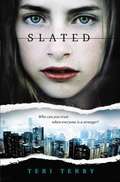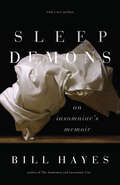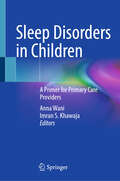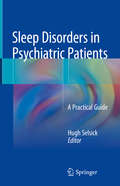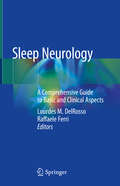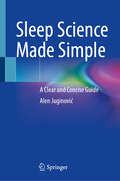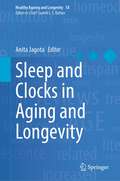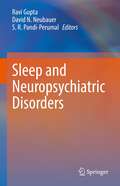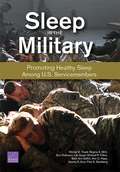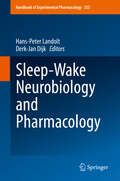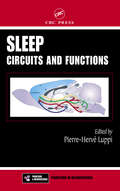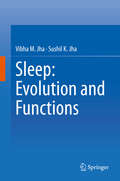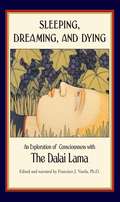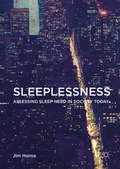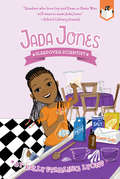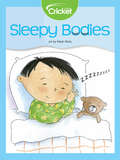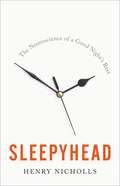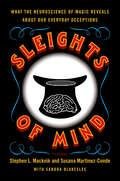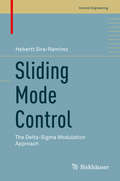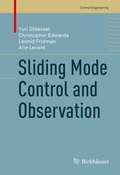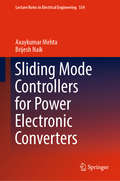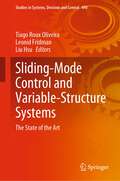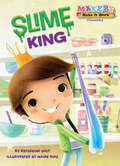- Table View
- List View
Slated
by Teri TerryKyla's memory has been erased, her personality wiped blank, her memories lost forever. She's been slated. The government claims that she was a terrorist and they are giving her a second chance--if she plays by their rules. But scenes from the past haunt her as she tries to adjust to a new life, family, and school, leaving her unsettled. Who is she really? And if only criminals are meant to be slated, why are so many other teens disappearing? As she and her friend Ben seek answers, Kyla is torn between the need to know more and her instinct for self-preservation.
Sleep Demons: An Insomniac's Memoir
by Bill Hayes“A lovely weave of memory and science, great characters and compassionate humor” from the author of Sweat: A History of Exercise (Anne Lamott).We often think of sleep as mere stasis, a pause button we press at the end of each day. Yet sleep is full of untold mysteries—eluding us when we seek it too fervently, throwing us into surreal dream worlds when we don’t, sometimes even possessing our bodies so that they walk and talk without our conscious volition. Delving into the mysteries of his own sleep patterns, Bill Hayes marvels, “I have come to see that sleep itself tells a story.”An acclaimed journalist and memoirist—and partner of the late neurologist Oliver Sacks—Hayes has been plagued by insomnia his entire life. The science and mythology of sleep and sleeplessness form the backbone to Hayes’s narrative of his personal battles with sleep and how they colored his waking life, as he threads stories of fugitive sleep through memories of growing up in the closet, coming out to his Irish Catholic family, watching his friends fall ill during the early years of the AIDS crisis in San Francisco, and finding a lover. An erudite blend of science and personal narrative, Sleep Demons offers a poignant introduction to the topics for which Hayes has since become famous, including art, eros, city life, the history of medical science, and queer identity.“This intimate and beautifully written book brings scientific research alive in a heartfelt and deeply personal narrative.” —The Guardian“Memoir, history, and science come together and apart again in a book that reads very much like a dream.” —Out magazine
Sleep Disorders in Children: A Primer for Primary Care Providers
by Imran S. Khawaja Anna WaniThis book fills the need for an evidence-based guide with practical insights on identifying, diagnosing, and treating sleep disturbances in children. It serves as a comprehensive guide for healthcare providers in various clinical settings. The book is structured in four sections that cover the importance of sleep, impact of sleep through the years, common sleep disorders, and sleep in special populations. Authored by leaders in the field, many chapters feature cases and offer clinical pearls. Sleep Disorders in Children provides primary care practitioners with information on common sleep disorders, the evaluation process, primary treatment, and when to refer them to a sleep specialist for further testing and treatment.
Sleep Disorders in Psychiatric Patients: A Practical Guide
by Hugh SelsickThis book is designed to give clinicians a practical guide to the detection, assessment and treatment of sleep disorders in patients with psychiatric illness in order to better treat both their sleep disorder and their psychiatric disorder. In addition to providing a thorough introduction to the major sleep disorders, it offers clear guidance on how to assess and manage these disorders in patients with a wide range of psychiatric conditions. The role of psychiatric medication and special considerations to be borne in mind when treating psychiatric patients are also addressed. Although it is aimed primarily at psychiatrists, this will also be a useful handbook for sleep clinics and general practitioners who frequently have to manage patients with both psychiatric and sleep disorders.
Sleep Neurology: A Comprehensive Guide to Basic and Clinical Aspects
by Lourdes M. DelRosso Raffaele FerriThis practical text provides knowledge of the basic neuroscience of sleep and sleep disorders as they interrelate with various neurologic conditions.Chapters in the first section cover neural networks involved in normal sleep processes, including dreams and memory. Also discussed are how these neural networks interact in various sleep stages and sleep disorders, such as sleep related movement disorders. The book's second section explores the pathophysiology of sleep disorders in the spectrum of neurologic conditions in both adults and children. This includes sleep changes in patients with dementia, seizures, headaches, and stroke, and other common neurologic disorders. Sleep Neurology fills an important gap in the sleep medicine literature by providing the underpinnings of sleep disorders and will be of great value to students, residents, and clinicians.
Sleep Science Made Simple: A Clear and Concise Guide
by Alen JuginovićThis book brings the fascinating world of sleep biology to life in clear, accessible language. Dr. Juginovic reveals what happens during the third of our lives we spend asleep—and why it matters so profoundly for our mental and physical health. Drawing on the latest research, the book demystifies how sleep works, explaining its powerful effects on everything from memory and metabolism to heart health, immunity, mental wellbeing, and even cancer risk. With vivid explanations and relatable examples, it explores the neurobiology of sleep and how this vital process supports nearly every system in the body. Whether you're new to the science of sleep, a healthcare professional, an athlete, or a business leader striving for high performance, this book offers something for everyone. Chapters break down complex concepts into clear, relatable language while preserving scientific depth and accuracy. Sleep Science Made Simple is more than just informative—it&’s a call to action. It invites readers to rethink their sleep habits, understand their importance, and make lasting changes to improve overall health, performance, and quality of life.
Sleep and Clocks in Aging and Longevity (Healthy Ageing and Longevity #18)
by Anita JagotaThis edited volume focuses on the interplay between sleep and circadian rhythms with health, aging and longevity. Sleep is absolutely important for human health and survival, as insufficient sleep is associated with a plethora of conditions, including the poor quality of life, onset of several diseases, and premature death. The sleep–wake cycle is an evolutionary conserved neurobiological phenomenon, and is a prominent manifestation of the biological clocks localised in the suprachiasmatic nucleus (SCN). Understanding bidirectional relationship between sleep and circadian rhythms is of utmost importance and urgency, especially in the context of modern lifestyle where sleep is often out of phase with the internal body clocks, social jetlag, artificial lights and so on. The 25 chapters by leading researchers and experts from 11 countries are arranged into seven sections: understanding sleep and clock interlink in health and longevity; sleep, aging and longevity; clock, aging and longevity; melatonin, sleep and clock; genetic regulation of sleep and clock; therapeutic interventions in sleep disorders and clock misalignment; and experimental models to study sleep and clocks in aging and longevity. This book is useful for advanced undergraduate and graduate students, and researchers, educators, and other biomedical professionals.
Sleep and Neuropsychiatric Disorders
by S. R. Pandi-Perumal Ravi Gupta David N. NeubauerThis book explores the intricate links between sleep and neuropsychiatric diseases. In clinical settings, understanding the development, treatment, and management of neuropsychiatric diseases poses a substantial challenge. Neuropsychiatric disorders place a significant cost on society, affecting the health of people affected, care providers, and the general community. Sleep and neuropsychiatric disease are inextricably linked. Sleep disorders are widespread in these populations and are frequently overlooked in neurology and psychiatry.The book offers readers up-to-date information on different facets of the bidirectional connections between sleep and neuropsychiatric diseases. Following the initial fundamental science part, a unique series of chapters concentrate on the behavioural manifestations of sleep problems, a hitherto unexplored field. Additional chapters include patient evaluation techniques as well as public health implications of sleep disorders. The individual chapters cover all main mental and neurological diseases where a change in sleep is evident, and recent concepts in pathogenesis, presentation, evaluation, and treatment. Neuropsychotropic drugs must be seen as a double-edged sword when it comes to sleep and sleep disorders. Overall, this book is an excellent resource for learning about neuropsychiatric diseases and how they affect sleep while simultaneously being impacted by sleep.
Sleep in the Military: Promoting Healthy Sleep Among U.S. Servicemembers
by Michael P. Fisher Regina A. Shih Paul S. Steinberg Eric Pedersen Wendy M. Troxel Lily Geyer Beth Ann Griffin Ann C. Haas Jeremy R. KurzGiven the unprecedented demands on the U. S. military since 2001 and the risks posed by stress and trauma, there has been growing concern about the prevalence and consequences of sleep problems. This first-ever comprehensive review of military sleep-related policies and programs, evidence-based interventions, and barriers to achieving healthy sleep offers a detailed set of actionable recommendations for improving sleep across the force.
Sleep-Wake Neurobiology and Pharmacology (Handbook of Experimental Pharmacology #253)
by Hans-Peter Landolt Derk-Jan DijkThis volume connects current ideas and concepts about sleep functions and circadian rhythms with the search for novel target-selective sleep-wake therapeutics. To do so, it provides a timely, state-of-the-art overview of sleep-wake mechanisms in health and disease, ongoing developments in drug discovery, and their prospects for the clinical treatment of sleep-disordered patients. It particularly focuses on the concept that sleep and wakefulness mutually affect each other, and the future therapeutic interventions with either sleep- or wake-promoting agents that are expected to not only improve the quality of sleep but also the waking behavior, cognition, mood and other sleep-associated physiological functions.The chapter 'Sleep Physiology, Circadian Rhythms, Waking Performance and the Development of Sleep-Wake Therapeutics' available open access under a CC BY 4.0 license at link.springer.com
Sleep: Circuits and Functions
by Pierre-Hervé LuppiAn estimated 40 million Americans and millions of others worldwide suffer from some type of sleep disruption or disorder, and these numbers are rapidly increasing. As biomedical technologies advance our understanding of sleep, a wave of developments in sleep research and the emergence of new technologies offer hope and help for a good night‘s
Sleep: Evolution and Functions
by Sushil K. Jha Vibha M. JhaThis book discusses the evolution of sleep and its possible function in the higher invertebrates and vertebrates, including humans. It describes the current concept of sleep and its functions, based on research on the mammalian system. To date, electrophysiological recordings of the brain waves, muscle activity, and eye movements are the only tools available for characterizing the sleep architecture in the majority of animals. In mammals and birds, only two distinct types of sleep are found – non-rapid eye movement (NREM) and rapid eye movement (REM) sleep. Since the discovery of REM sleep, studies have been performed to understand the purpose of the two distinct sleep states in higher vertebrates (birds and mammals), and how REM sleep was evolved. The book summarizes the role of both REM and NREM sleep in the proper functioning of the brain and body. It covers various aspects of the role of sleep in important physiological processes, including memory consolidation, induction of synaptic plasticity, energy restoration, enhancing immune response, and maturation of neuronal circuitries during early life. Lastly, the book reviews the effects of chronic/acute sleep deprivation on memory consolidation, obesity, and the immune system in animal models and humans.
Sleeping, Dreaming, and Dying
by Thupten Jinpa His Holiness the Dalai Lama B. Alan Wallace Francisco J VarelaThis is an absorbing account of a dialogue between leading Western scientists and the foremost representative of Buddhism today, the Dalai Lama of Tibet. For modern science, the transitional states of consciousness lie at the forefront of research in many fields. For a Buddhist practitioner these same states present crucial opportunities to explore and transform consciousness itself. This book is the account of a historic dialogue between leading Western scientists and the Dalai Lama of Tibet. Revolving around three key moments of consciousness--sleep, dreams, and death--the conversations recorded here are both engrossing and highly readable. Whether the topic is lucid dreaming, near-death experiences, or the very structure of consciousness itself, the reader is continually surprised and delighted. Narrated by Francisco Varela, an internationally recognized neuroscientist, the book begins with insightful remarks on the notion of personal identity by noted philosopher Charles Taylor, author of the acclaimed Sources of Self. This sets the stage for Dr. Jerome Engel, Dr. Joyce MacDougal, and others to engage in extraordinary exchanges with the Dalai Lama on topics ranging from the neurology of sleep to the yoga of dreams. Remarkable convergences between the Western scientific tradition and the Buddhist contemplative sciences are revealed. Dr. Jayne Gackenbach's discussion of lucid dreaming, for example, prompts a detailed and fascinating response from the Dalai Lama on the manipulation of dreams by Buddhist meditators. The conversations also reveal provocative divergences of opinion, as when the Dalai Lama expresses skepticism about "Near-Death Experiences" as presented by Joan Halifax. The conversations are engrossing and highly readable. Any reader interested in psychology, neuroscience, Buddhism, or the alternative worlds of dreams will surely enjoy Sleeping, Dreaming, and Dying.
Sleeplessness
by Jim HorneThis book critically evaluates the popular notionthat today's society is suffering from 'sleep debt', or what Horne calls'societal insomnia' - an apparent chronic loss of sleep, which can lead toobesity and related physical and mental disorders including heart disease. It presents evidence which suggests thatsleep debt has not in fact worsened to any marked extent over the last hundredor so years, by looking back at some historical writings on sleeplessness andintegrating the findings with, evidence-based research that he has undertakenover the last decade. Written in a concise andunderstandable way, and interwoven with real-world insights, the book will beuseful to academic and students of cognitive, critical and social psychology,neuroscience and sociology, as well as anyone who is interested in the socialand psychological implications of sleep and sleeplessness.
Sleepover Scientist (Jada Jones #3)
by Vanessa Brantley-Newton Kelly Starling Lyons Nneka MyersJada Jones is back for the third book of this popular, celebrated series perfect for STEM fans!Jada is hosting her first sleepover, and she has lots of cool scientific activities planned: kitchen chemistry, creating invisible ink, and even making slime! But when her friends get tired of the lessons and just want to hang out, can Jada figure out the formula for fun and save the sleepover?
Sleepy Bodies
by Amy TaoWhat happens to your body while you sleep? Does it just shut off like the bedroom light? On the contrary, it turns out that all sorts of things happen.
Sleepyhead: The Neuroscience of a Good Night's Rest
by Henry NichollsA narcoleptic's tireless journey through the neuroscience of disordered sleepWhether it's a bout of bad jet lag or a stress-induced all-nighter, we've all suffered from nights that left us feeling less than well-rested. But for some people, getting a bad night's sleep isn't just an inconvenience: it's a nightmare. In Sleepyhead, science writer Henry Nicholls uses his own experience with chronic narcolepsy as a gateway to better understanding the cryptic, curious, and relatively uncharted world of sleep disorders. We meet insomniacs who can't get any sleep, narcoleptics who can't control when they sleep, and sleep apnea victims who nearly suffocate in their sleep. We learn the underlying difference between morning larks and night owls; why our sleeping habits shift as we grow older; and the evolutionary significance of REM sleep and dreaming. Charming, eye-opening, and deeply humanizing, Sleepyhead will help us all uncover the secrets of a good night's sleep.
Sleights of Mind: What the Neuroscience of Magic Reveals About Our Everyday Deceptions
by Sandra Blakeslee Stephen L. Macknik Susana Martinez-Conde"This book doesn't just promise to change the way you think about sleight of hand and David Copperfield—it will also change the way you think about the mind." —Jonah Lehrer, author of How We Decide and Proust Was A Neuroscientist Stephen Macknik and Susana Martinez-Conde, the founders of the exciting new discipline of neuromagic, have convinced some of the world's greatest magicians to allow scientists to study their techniques for tricking the brain. This book is the result of the authors' yearlong, world-wide exploration of magic and how its principles apply to our behavior. Magic tricks fool us because humans have hardwired processes of attention and awareness that are hackable—a good magician uses your mind's own intrinsic properties against you in a form of mental jujitsu. Now magic can reveal how our brains work in everyday situations. For instance, if you've ever bought an expensive item you'd sworn you'd never buy, the salesperson was probably a master at creating the "illusion of choice," a core technique of magic. The implications of neuromagic go beyond illuminating our behavior; early research points to new approaches for everything from the diagnosis of autism to marketing techniques and education. Sleights of Mind makes neuroscience fun and accessible by unveiling the key connections between magic and the mind.
Slick Water
by Andrew NikiforukThe fossil fuel industry and many environmental groups tout hydraulic fracturing - "fracking" - as a panacea, with slick promises of energy independence, greenhouse gas reductions, and benefits to local economies. Yet the controversial technology, which blasts massive volumes of fluids, sand, and chemicals into rock and coal formations, has sparked huge public protests. Slick Water tells the shocking, inspiring story of one woman's stand to hold government and industry accountable for the damage fracking leaves in its wake.After energy giant Encana secretly fracked hundreds of gas wells around her home and her well water turned to a flammable broth, Jessica Ernst started asking questions. When she put forward evidence that Encana had violated laws by fracturing the community's drinking water aquifer, Ernst was falsely tagged as a bomb-making terrorist and visited by the government's anti-terrorism squad. Frightened but undaunted, she uncovered a startling history of liability, fraud, and intimidation, along with a willful denial of widespread groundwater contamination. Jessica Ernst's remarkable story raises dramatic questions about the role of Big Oil in government, society's obsession with rapidly depleting supplies of unconventional oil and gas, and the future of civil society.
Sliding Mode Control
by Hebertt Sira-RamírezThis monograph presents a novel method of sliding mode control for switch-regulated nonlinear systems. The Delta Sigma modulation approach allows one to implement a continuous control scheme using one or multiple, independent switches, thus effectively merging the available linear and nonlinear controller design techniques with sliding mode control. Sliding Mode Control: The Delta-Sigma Modulation Approach, combines rigorous mathematical derivation of the unique features of Sliding Mode Control and Delta-Sigma modulation with numerous illustrative examples from diverse areas of engineering. In addition, engineering case studies demonstrate the applicability of the technique and the ease with which one can implement the exposed results. This book will appeal to researchers in control engineering and can be used as graduate-level textbook for a first course on sliding mode control.
Sliding Mode Control and Observation
by Christopher Edwards Leonid Fridman Arie Levant Yuri ShtesselThe sliding mode control methodology has proven effective in dealing with complex dynamical systems affected by disturbances, uncertainties and unmodeled dynamics. Robust control technology based on this methodology has been applied to many real-world problems, especially in the areas of aerospace control, electric power systems, electromechanical systems, and robotics. Sliding Mode Control and Observation represents the first textbook that starts with classical sliding mode control techniques and progresses toward newly developed higher-order sliding mode control and observation algorithms and their applications. The present volume addresses a range of sliding mode control issues, including: *Conventional sliding mode controller and observer design *Second-order sliding mode controllers and differentiators *Frequency domain analysis of conventional and second-order sliding mode controllers *Higher-order sliding mode controllers and differentiators *Higher-order sliding mode observers *Sliding mode disturbance observer based control *Numerous applications, including reusable launch vehicle and satellite formation control, blood glucose regulation, and car steering control are used as case studies Sliding Mode Control and Observation is aimed at graduate students with a basic knowledge of classical control theory and some knowledge of state-space methods and nonlinear systems, while being of interest to a wider audience of graduate students in electrical/mechanical/aerospace engineering and applied mathematics, as well as researchers in electrical, computer, chemical, civil, mechanical, aeronautical, and industrial engineering, applied mathematicians, control engineers, and physicists. Sliding Mode Control and Observation provides the necessary tools for graduate students, researchers and engineers to robustly control complex and uncertain nonlinear dynamical systems. Exercises provided at the end of each chapter make this an ideal text for an advanced course taught in control theory.
Sliding Mode Controllers for Power Electronic Converters (Lecture Notes In Electrical Engineering #534)
by Axaykumar Mehta Brijesh NaikThis book proposes a proportional integral type sliding function, which does not facilitate the finite reaching and hence the responses of the load voltage results in an exponential steady state. To facilitate finite time reaching, it also presents the new Integral Sliding Mode Control with Finite Time Reaching (ISMCFTR). The book also extends the application of the proposed controller to another type of PEC, the DC-DC Boost converter, and also proposes the PI type sliding surface for the Zeta converter, which is non-inverting type Buck Boost converter. An important source of practical implementations, it presents practical implementations as simulation and experimental results to demonstrate the efficacy of the converter.
Sliding-Mode Control and Variable-Structure Systems: The State of the Art (Studies in Systems, Decision and Control #490)
by Leonid Fridman Tiago Roux Oliveira Liu HsuThis book reflects the latest developments in sliding-mode control (SMC) and variable-structure systems (VSS), comprising contributions by leading researchers and an international range of experts. Such contributions highlight advances in various branches of the field—conventional and higher-order SMC with continuous- and discrete-time implementation and theory and applications both receive attention.The book consists of six parts. In the first, new SMC/VSS algorithms are proposed and their properties are analyzed. The second part focuses on the use of observers to solve the estimation and output-feedback control problems. The third part discusses the discretization aspects of SMC algorithms. Parts IV and V provide important insights on the use of adaptation laws for non-overestimated control gains and chattering alleviation. The last part examines the applications of these SMC/VSS ideas to real-world systems. Sliding-Mode Control and Variable-Structure Systems introduces postgraduates and researchers to the state of the art in the field. It includes theory, methods, and applications relevant to workers in disciplines including control, automation, applied mathematics, electrical and mechanical engineering, instrumentation, electronics, computer science, robotics, transportation, and power engineering. Its clear style and deep exposition help readers to keep in touch with tools that are, thanks to the robustness and insensitivity to perturbations of the SMC/VSS paradigm, among the most efficient for dealing with uncertain systems.
Sliding-Mode Control of PEM Fuel Cells
by Cristian Kunusch Paul Puleston Miguel MayoskySliding-mode Control of PEM Fuel Cells demonstrates the application of higher-order sliding-mode control to PEMFC dynamics showing the advantages of sliding modes. The book introduces the theory of fuel cells and sliding-mode control. It contextualises PEMFCs both in terms of their development and within the hydrogen economy and today's energy production situation as a whole. It then discusses fuel-cell operation principles, the mathematical background of high-order sliding-mode control and to a feasibility study for the use of sliding modes in the control of an automotive fuel stack. Part II presents experimental results of sliding-mode-control application to laboratory fuel cells and deals with subsystem-based modelling, detailed design, and observability and controllability. Simulation results are contrasted with empirical data and performance, robustness and implementation issues are treated in depth. Possibilities for future research are also laid out.
Slime King (Makers Make It Work)
by Catherine DalyTying into the popular Makers Movement, Makers Make it Work is a series of fun easy-to-read stories that focus on problem-solving and hands-on action. With bright, eye-catching art and explanatory sidebars with additional information on the topic, these books show kids how to use their hands, their heads, their creativity, and their problem-solving skills to overcome every challenge facing them. Leo is the king of slime. He even has his own slime-making business! His parents just ask him to keep up his grades. The only problem? Science class! With the Makers Make It Work series, any kid can be a Maker! Each book also includes an activity for young makers to try themselves. (Topic: Chemistry)
